How to sew a corset with your own hands - from sewing to sewing

Of course, the corset is the main part of the wedding dress. It still remains stylish and irreplaceable for emphasizing the beauty of the bride's figure. It can be decorated with embroidery, rhinestones, pearls, feathers, bows, which will make the dress more original and special. That is why, when sewing a wedding dress, one of the key points is how to sew a corset with your own hands. This, of course, is not an easy task that requires thorough preparation.


Views
When modeling an outfit, take into account such nuances as the purpose of the bodice, material, type of figure. Also note that basic bodice patterns are equally suitable for an evening dress, wedding or casual. It all depends on the decor and fabric.
Consider the main types of corsets.
Decorative
This type is intended for girls with a figure that does not require adjustment. It is often also called a corsage. Therefore, such a corset is classified as ordinary clothing. Perfect for brides with a perfect figure and pregnant women.
Slimming
Designed for body shaping (shape changes): lifting the chest, shaping the waistline, supporting the back. With such a corset, the bride is more graceful and graceful.
Materials (edit)
For sewing, they mainly use dense fabric (cotton can be used) for lining, then the upper fabric (main) is sewn from the same fabric or from any one you like, for example, satin, guipure, lace. The advantage of the density of the fabric is that it will not give the product a wrinkled appearance and unnecessary folds. If the corset is decorative, you can use silk.
The accessories include the following corset fasteners:
- locks;
- eyelets;
- ties for lacing;
- hooks;
- buttons;
- whalebone for a slimming corset;
- spiral bones for curved seams;
- steel bones for straight seams. It is better not to take cheap plastic bones, as they bend and curl.
Lacing is done either in the front or in the back, or two at once. For tightening corsets, it is good in that you can adjust the tightening force by adjusting the corset to the desired size, regardless of whether you get better over time or lose weight. The main thing is to know when to stop and not to overdo it in tightening the corset.
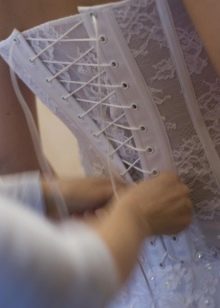
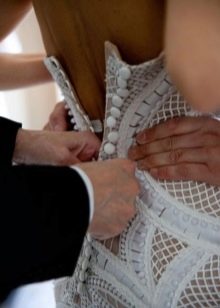
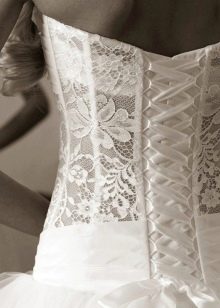
It is better to buy bones already having a pattern on your hands and, of course, knowing the length of the corset. Self-reduction of the bone can bring some trouble. Please note that the bone should be 2 cm shorter than the seam of the corset, so it will not be noticeable and will not tear the fabric.
You will also need such tools.:
- ruler;
- fabric hole punch;
- disappearing marker for pattern modeling;
- cellophane strips;
- scissors;
- hammer for securing eyelets;
- sewing machine;
- rotary knife;

Choosing a template
Having decided on the style, the purpose of the corset (slimming, decorative), its appearance (modern, retro or even business style), the shape of the breast cut, length, etc., try stitching it out of cheap fabric as a mockup.



The advantage of the template is that it can be corrected at different stages of sewing. With a clean version, this will be more difficult to do. Also keep in mind that sewing a corset takes quite a long time and it is the rough version that will shorten it, especially if you are sewing it for the first time.
Taking measurements
Whichever pattern of corset, dress, skirt or other type of clothing you choose, it should correspond to your body type and fit only your body size. This is the main rule.
To take measurements, measure:
- chest girth;
- waist circumference (in the place where you want to make it);
- hip girth (along the line of protruding bones);
- also measure the distances: waistline - point under the chest, waistline - bottom along the side seam, waistline - lower abdomen.
Modeling methods
There are 2 ways to build a pattern:
- Estimated - taking the necessary measurements depending on the chosen model and building a pattern.
- Dummy or tattoo method - the method does not take much time (10-20 minutes depending on the complexity of the model), but accurate, taking into account the characteristics of the figure. In this case, the matter is impaled directly onto a human figure or a mannequin.

Building a pattern in a dummy way
Now the tattooing method is gaining popularity. Let's stop at it.
To make a pattern, prepare a mannequin, a disappearing felt-tip pen and cellophane strips 20 cm wide and 40-45 cm long. The number of stripes depends on the planned number of parts.
- We draw a corset. Tie the laces on the mannequin (you can use elastic bands) horizontally along the chest line, under the chest and at the waist, as well as on the stomach (12-13 cm from the waist line).
- Draw lines along the knotted laces with an erasable marker, then remove them.
- Mark out the side seams and the center of the front and back.
- Mark the raised seams for the corset.
- Take a cellophane strip and place it on the center of the front of the mannequin. Transfer the lines of the first part (from fold to relief) with a pen.
- Attach and transfer side piece and back pieces.
- Remove the parts and check for evenness of the relief line.
- Add seam allowances.
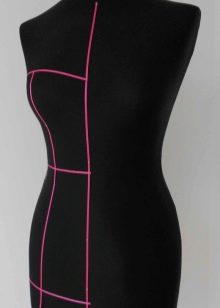

You will approximately get such a pattern.
The traditional way is settlement
Let's model the corset pattern.
1. Take out a basic pattern for the dress or draw a rectangular mesh and mark on it a line for the waist, chest and hips in accordance with your measurements, using one of the patterns as an example. On the main pattern, transfer the lines and emboss the cutouts. Make a template, while be sure to make seam allowances - 2-3 cm.
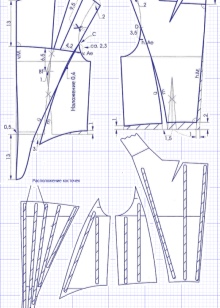
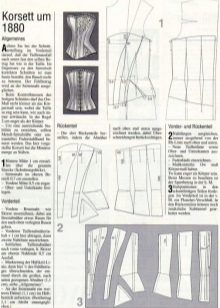
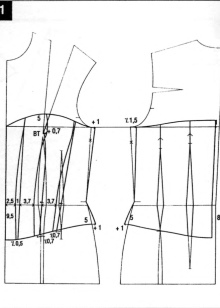
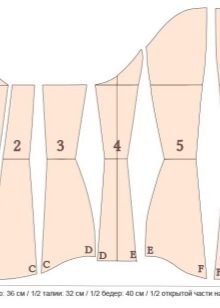
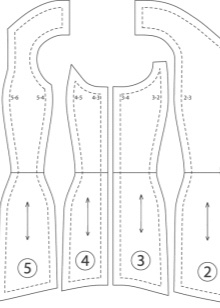
2. Transfer the pattern to the corset template fabric. Position the piece so that the center cut of the back is parallel to the longitudinal thread, respectively, the points of alignment of the parts along the waist line are parallel to the weft thread. That is, the corset should not stretch along the waist line. Basically, the left side duplicates the right one, so you can fold the fabric in two layers if the material of the lining and the main fabric is different, and immediately cut out a couple of parts. If you are sewing from the same fabric, fold it into 4 layers, aligning the edges.
3. Open the fabric.
To make the fabric “shrink” better, soak it in warm water before sewing, having previously numbered the details.
Sewing
How to sew a corset:
1. Sweep the center template parts of the front with the side ones, as well as the center parts of the back with the side ones from the pad. Sew the shelves with the side details of the back. Try on the product and make any necessary adjustments.
2. Sew and iron all seams.
3. Do the same with the base fabric. If there were changes in the lining, they are carried over to the base.
4. Connect the outside to the backing.
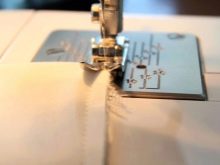
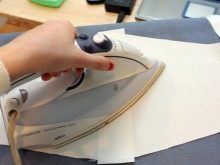
5. Stitch the drawstrings at the side seams and insert bones into them. Their length should be 2 cm less than the seam. The underwire should be between the lining and the main fabric when sewing. Also note that the side seams of the two pieces (back and front) must match. You can also make drawstrings on both sides of the seam.
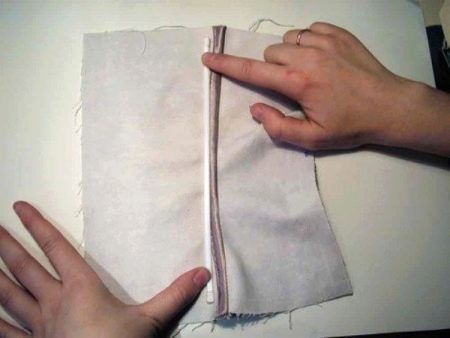
6. Instead of drawstrings, you can add rigilin. In this case, it is adjusted to the lining and to the base, and then the parts are connected. To do this, step back from the top of the side seam by 2 cm and secure it with two lines. The ends of the regilin should be wrapped with masking tape. Be sure to tie top and bottom bartacks.
Clasp decoration
If you opted for lacing, make markings for the eyelets on the shelves. Punch holes for them and make sure they hold tight.
To make eyelets:
- cut a long strip from the fabric, depending on the density of the loops on the shelf of the corset;
- from the seamy side, sew it to the desired width;
- twist the strip by hooking a pin over the edge;
- cut it into strips, for example 7 cm long, take into account the width of the tape or lace;
- Neaten the edges of the segments so that the fabric does not crumble;
- insert the loops between the layers of the corset fabric on both shelves, keeping the same width;
- sew the eyelets and pull in the cord or tape. You can also sew the ribbon from the main fabric. To do this, you need to sew a long strip of the desired width, turn it out, straighten the top stitched edge and carefully sew the bottom edge.
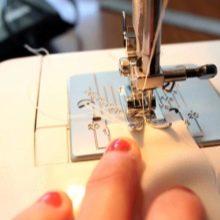
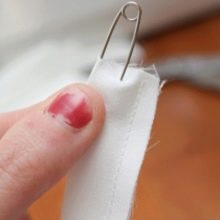

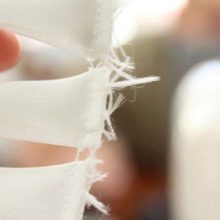
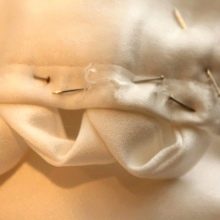

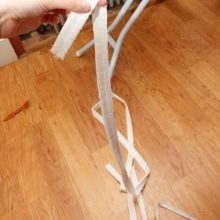

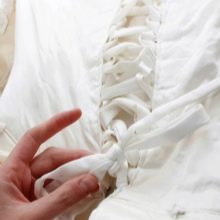
Concealed zipper can be sewn in and hidden behind the button closure.
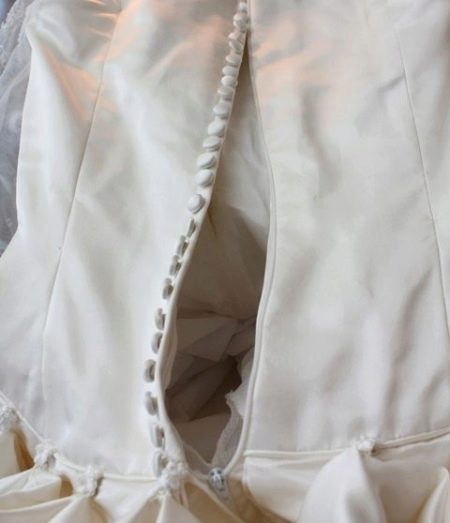
It remains, if you wish, to decorate the corset with lace, rhinestones, beads, bows.












It takes a lot of experience to sew a corset. This is not such a simple matter.
Rita, were you born with experience? Or do you have to sit and wait for the "experience" to come, then start sewing?
If you never start, where does the experience come from? The main thing is desire and accessories for sewing. There is nothing complicated.
Very detailed and understandable! Thanks.